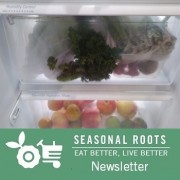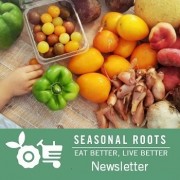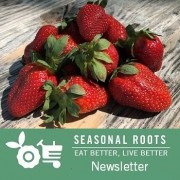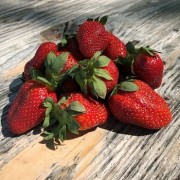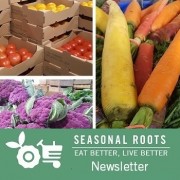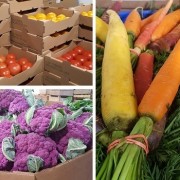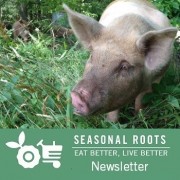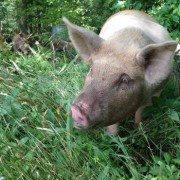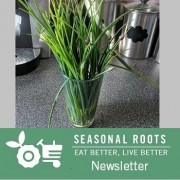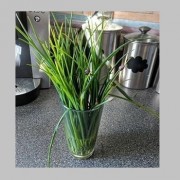Discover their amazing super powers
– By the Veggie Fairy Team:
Spring’s a great time to go local, because to tell the truth, no list can do justice to spring’s amazing bounty. Every spring, Virginia’s fields overflow with foods bursting with flavor and nutrition and week by week, they’re all on offer in our online farmers market. It was really hard to settle on just ten spring superfoods, so treat this list as a starting point for enjoying Mother Nature’s seasonal treats! To make it easy, we’ve included links to inspiring recipes on our Pinterest boards for each and every item on the list.
Asparagus
These spears are one of the best veggie sources of folate, a B vitamin that could help boost your mood. Folate plays an important role in synthesizing the neurotransmitters dopamine, serotonin, and norepinephrine, all crucial for a happy day. A single cup of cooked asparagus has two-thirds of the recommended daily allowance of folate for women! Asparagus is also rich in folic acid, which helps the body produce and maintain new cells. Plus it’s got potassium, fiber, vitamins C, A, and B6, and thiamine, it’s an antioxidant, and it has anti-inflammatory properties. Whew! Try this recipe: Spaghetti With Asparagus and Lemon Balm
Beets
Beets are a superfood for the liver. They contain a substance called betaine which has a powerful positive impact on the liver’s detoxification pathways. Beets can also aid in reducing systemic inflammation in the body. Steam or roast them, then eat ’em as a side or chop them up for salads. Cook beets in batches and store them in the fridge — they store well. Try this recipe: Chocolate & Balsamic Roasted Beets
Blueberries
Eat up and you may score big for your brain. In a recent study, people with age-related memory decline who drank roughly two and a half cups of blueberry juice per day for 12 weeks (the equivalent of eating a cup of blueberries) made significant improvements on memory and learning tests compared with those who drank a placebo juice. Now that’s a whole lotta berries, but even some blueberries are sure to benefit you. Turns out blueberries have a type of antioxidant that’s been shown to increase signals among brain cells and improve their resilience. That helps enhance learning and memory. Try this recipe: Quinoa Blueberry Salad
Bok choy
One cup of bok choy has just 9 calories and barely a trace of fat, yet delivers protein, dietary fiber and almost all the essential vitamins and minerals. It’s rich in antioxidants and helps build strong bones, a healthy heart, and may help protect against cancer. As for taste, one of our members described it as tasting like spinach and celery had a yummy baby! We love that! Try this recipe: Tom Tom Chicken
Dandelion greens
Before you pull that “weed” out of your lawn, remember this: In early spring, tender young dandelion greens have four times as much calcium, 1.5 times as much vitamin A, and 7.5 times as much vitamin K as broccoli. Also twice as much iron and three times as much riboflavin as spinach — which provides no vitamin E or carotenoids. But dandelion greens do, with 17 percent of the daily adult dose of vitamin E and 13,610 international units, or IUs, of lutein and zeaxanthin per 3.5-ounce serving. Try this recipe: Dandelion Salad with Bacon & Mushrooms
Garlic scapes/green garlic/spring garlic
Green or spring garlic is immature garlic and looks like a slightly overgrown scallion. It’s often mistaken for garlic scapes but while spring garlic is harvested before the garlic bulb attains its full size, garlic scapes are harvested later — they’re the curly shoots that form later in the season. These shoots look like green stalks with closed buds on top and may help with weight loss — they contain a compound called allicin, which gives garlic its pungent smell and may keep you from overeating by stimulating satiety in the brain. Try this recipe: Cilantro Black Rice with Roasted Garlic Scapes & Asparagus
Lettuce (field)
In the spring, our local field lettuce is ready for your salads and more. The darker the lettuce, the more good-for-you stuff it’s likely to contain. Lettuce can deliver moisture, energy, protein, fat, carbohydrates, dietary fiber, and sugars. Its minerals include calcium, iron, magnesium, phosphorus, potassium, sodium, and zinc, and its got vitamins like thiamin, riboflavin, niacin, folate, vitamin B6, C, A, E, and vitamin K. Lettuce can help with lowering cholesterol levels, preventing cancer, protecting neurons, sleeping better, controlling anxiety, lowering inflammation, and supplying antioxidants. Amazing! Try this recipe: Easy Ginger Beef Lettuce Wraps
Peas (garden, snap, snow)
They’re loaded with fiber, protein, and micronutrients but low in calories, which means they will keep you feeling full without blowing through your daily calorie allotment. They also have high levels of iron, calcium, zinc, copper, and manganese, which can help boost immunity. Try this recipe: Pea & Herbed Goat Cheese Tart
Radishes
Oh, the radish! It’s at its sweet, crunchy best in the spring. Radishes are very good for the liver and stomach, and they act as a powerful detoxifier too. Radishes are considered roughage, which means they’re composed of indigestible carbohydrates. That’s good for digestion, water retention, and helps prevent or undo constipation. They’re good for your skin, your cardiovascular system, your urinary tract, your — oh, just read this, we can’t list it ALL here! Then try this recipe: Cinnamon Sugar Radish Chips
Strawberries
They may not have the smoothest complexion themselves, but strawberries are great for your skin. Who knew?! Their secret is the antioxidants they’re packed with — antioxidants help your skin repair damage caused by environmental factors like pollution and UV rays. Plus, they’re full of so much vitamin C that less than a cup gets you your entire recommended daily allowance. And vitamin C is associated with fewer wrinkles and less dryness, per research in the American Journal of Clinical Nutrition. Try them in a homemade facial, too — if you can stand not eating them. If you’re like us, you’ll rather try this recipe instead: Strawberry Smoothie
There’s more on some of the science we’ve mentioned here in this article. Now get eating!
ABOUT SEASONAL ROOTS
Since 2011, Seasonal Roots’ online farmers market has connected Virginia families with local family farmers who use sustainable, humane practices. Our veggie fairies – mostly moms who believe in living better through scrumptious, healthy eating, being kind to animals, protecting the environment, and spreading joy – home-deliver freshly harvested produce, eggs, grass-fed dairy and meat, plus artisan fare. We empower our members to eat better and live better with more nutritious, flavorful food that’s good for us and good for the planet. More info at seasonalroots.com.
